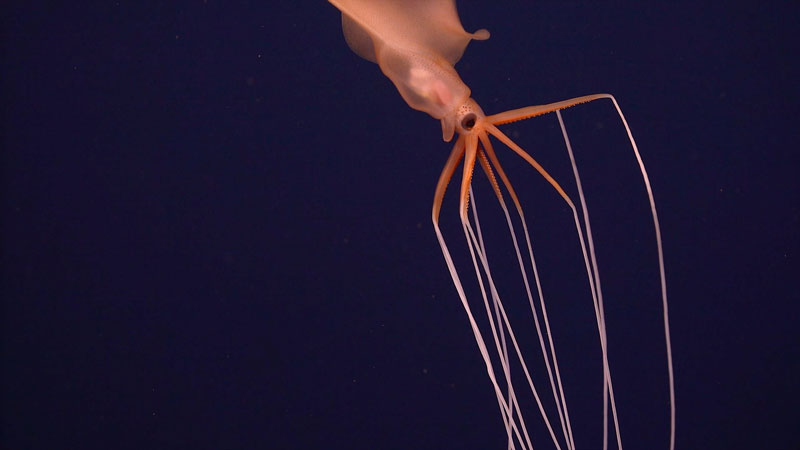
In Search of Hydrothermal Lost Cities: Searching for Serpentinization-Driven Hydrothermal Activity on Oceanic Core Complexes of the Mid-Atlantic Ridge
Past Expedition
Overview
Scientists discovered three new hydrothermal vent fields during an expedition to the Mid-Atlantic Ridge from March 3 to April 11, 2023, on Schmidt Ocean Institute’s new research vessel Falkor (too).

Download largest version (jpg, 418 KB).
This expedition, the first scientific expedition on Falkor (too), was a multipronged exploration project designed to accelerate discovery and characterization of deep-sea hydrothermal systems. The scientists targeted areas of the seafloor near the slow-spreading Mid-Atlantic Ridge where mantle rocks are exposed to seawater (oceanic core complexes), and where the chemical reaction between these rocks and seawater, known as serpentinization, can result in hydrothermal activity.
How They Did It
The team employed a nested approach with a suite of cutting-edge technologies in their search for active hydrothermal vents. This approach entailed:
- Mapping the seafloor with the ship’s multibeam sonar system to identify promising areas for further investigation.
- Collecting physical ocean data with a conductivity, temperature, depth instrument (CTD) and an oxidation reduction potential (ORP) sensor to look for signs of hydrothermal activity and further narrow the search.
- Collecting physical ocean data and higher resolution seafloor mapping data with autonomous underwater vehicles (AUVs) equipped with multiple sensors, including miniature autonomous plume recorders, to locate sources of hydrothermal plumes.
- Exploring sites of interest (based on data collected) with remotely operated vehicle (ROV) SuBastian and its associated imagery, sample, and data collection tools, including a recently developed methane sensor that can confirm active venting in real time.
What They Found
Using this approach, the scientists explored three distinct areas along a 700-kilometer-long (435-mile-long) section of the Mid-Atlantic Ridge and found previously undiscovered high-temperature, black smoker hydrothermal vent fields in all three. Prior to this expedition only two other such vent fields had been discovered here, both in the 1980s.
During the exploration of these areas, the team mapped 170 square kilometers (65 square miles) of seafloor in high resolution (1-meter scale) over 18 successful AUV deployments and produced maps for two oceanic core complexes. In addition, they characterized fluid chemistry, mineralogy, and biological communities from the three new fields. Sample analysis will continue on shore post-expedition.
Contributions to Ocean Science
This expedition:
- Showed that an accelerated process of exploration and characterization with a multidisciplinary team on a ship with AUV and ROV capabilities can rapidly find new hydrothermal sites and collect essential information about their geology, chemistry, and biology.
- Provided new data to improve understanding of the distribution of animals at vents along the Mid-Atlantic Ridge.
- Provided baseline information about the presence of animal communities and their colonization of hydrothermal vents to inform evaluation of the potential impacts of deep-sea mining of hydrothermal metal sulfide deposits for regional planning purposes.
- Provided new geological/geochemical data on oceanic core complexes, furthering our knowledge about these geological features.
- Showed that Falkor (too) is a powerful new tool for deep-ocean science and exploration.
While the team didn’t find another example of alkaline venting driven by serpentinization, as seen at the Lost City hydrothermal field, the discovery of the three black smoker vent fields was thrilling and history-making in itself. These three fields add important information about the distribution and character of hydrothermal venting on the Mid-Atlantic Ridge to the existing knowledge base, and they will certainly be targets for further investigation by international scientific teams.

Download largest version (jpg, 4.48 MB).

Download largest version (jpg, 7.44 MB).

Download largest version (jpg, 3.11 MB).

Download largest version (jpg, 2.26 MB).
More information about this expedition, including videos and blogs, is on Schmidt Ocean Institute’s expedition-specific web page. View full-length recordings of the ROV dives on YouTube.
This collaborative project involved Schmidt Ocean Institute, NOAA Ocean Exploration, NOAA’s Pacific Marine Environmental Laboratory, the University of Washington, Oregon State University, Woods Hole Oceanographic Institution, MBARI (Monterey Bay Aquarium Research Institute), the University of Victoria, University of Toronto, Dalhousie University, and IFREMER (Institut Français de Recherche pour l’Exploitation de la Mer).
Published May 5, 2023
Multimedia
Featured multimedia assets associated with this project.
Education
Our Learn & Discover page provides the best of what the NOAA Ocean Exploration website has to offer to support educators in the classroom during this expedition. Each theme page includes expedition features, lessons, multimedia, career information, and associated past expeditions. Below are related top education themes for this expedition.
Resources & Contacts
- NOAA Pacific Marine Environmental Laboratory
- Cooperative Institute for Climate, Ocean, & Ecosystem Studies (University of Washington)
- Cooperative Institute for Marine Ecosystem and Resources Studies (Oregon State University)
- Schmidt Ocean Institute
- Woods Hole Oceanographic Institution
- MBARI (Monterey Bay Aquarium Research Institute)
- University of Victoria
- University of Toronto
- Dalhousie University
- IFREMER (Institut Français de Recherche pour l’Exploitation de la Mer)
-
Emily Crum
Communication Specialist
NOAA Ocean Exploration
ocean-explore-comms@noaa.gov -
Carlie Wiener
Director of Communications and Engagement Strategy
Schmidt Ocean Institute
cwiener@schmidtocean.org
